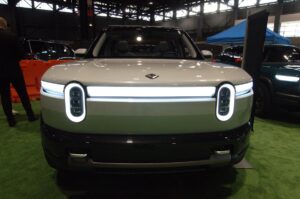Rivian’s Fourth Quarter Highlights: A Step Towards Profitability
Rivian Automotive (RIVN) recently announced impressive fourth-quarter results that exceeded market expectations, marking a significant milestone in its journey toward profitability. The company achieved a gross profit of $170 million, attributed to strategic improvements in variable costs, an increase in revenue per delivered unit, and effective management of fixed costs. This positive development underscores Rivian’s commitment to enhancing cost efficiency as it prepares for the upcoming launch of its mass-market R2 product.
Key Financial Metrics
In comparison to analysts’ forecasts, Rivian’s revenue reached $1.73 billion, surpassing the anticipated $1.38 billion and reflecting a notable 32% increase from the previous year’s figure of $1.31 billion. This performance is indicative of a company that is effectively scaling operations while managing costs. Notably, the adjusted loss per share came in at $0.46, beating the consensus estimate of $0.65, while the adjusted EBITDA loss of $277 million was better than the anticipated $399.8 million.
Cost Efficiency and Future Production
CEO RJ Scaringe highlighted Rivian’s focus on reducing costs per vehicle, successfully lowering the automotive cost of goods sold by $31,000 per unit delivered in Q4 2024 compared to Q4 2023. This proactive cost management is especially critical as the company gears up for the R2 launch, with 95% of the bill of materials sourced and expected to be approximately half that of the R1 series.
Looking ahead, Rivian projects a full-year adjusted EBITDA loss for 2025 between $1.7 billion and $1.9 billion, alongside vehicle deliveries estimated to fall between 46,000 to 51,000 units. However, CFO Claire McDonough has cautioned that Q1 deliveries might be lower due to seasonal factors as well as disruptions caused by wildfires in California, a key market for Rivian’s electric vehicles (EVs).
Cash Reserves and Strategic Partnerships
While Rivian has shown solid progress, it’s worth noting that the company’s cash reserves have decreased considerably from $7.85 billion to $5.29 billion over the year. This decline emphasizes the importance of innovative strategies and partnerships for sustaining operations while moving towards profitability.
Rivian’s collaboration with Volkswagen, forged in November, aims to leverage Rivian’s advanced "zonal architecture" for the R2 SUV, which is slated for release in the first half of 2026. Additionally, Rivian has secured a conditional commitment for a $6.6 billion loan from the Department of Energy (DOE) under its Advanced Technology Vehicles Manufacturing (ATVM) program, which will support the construction of a new assembly plant near Atlanta. However, shifting political landscapes could pose challenges to these funding avenues.
Regulatory Landscape and Tax Credits
As Rivian advances, it faces uncertainties in the regulatory environment, particularly concerning the federal EV tax credit. With recent political shifts, there is speculation around potential repeals of incentives that benefit automakers like Rivian, Tesla (TSLA), and Lucid (LCID).
This context makes Rivian’s recent announcement to open up orders for its Electric Delivery Vehicles (EDV) noteworthy. Expanding its commercial offerings could diversify revenue streams as the company aims to bolster its financial performance.
Final Thoughts
Rivian’s latest results indicate a determined effort to balance being a startup in the automotive sector with the operational realities of scale and profitability. As Rivian continues to refine its processes, manage costs, and engage in strategic partnerships, investors and EV enthusiasts alike will be keen to see how these dynamics play out in the coming quarters.
For more in-depth insights and the latest updates on Rivian and other financial news, keep following Extreme Investor Network.

